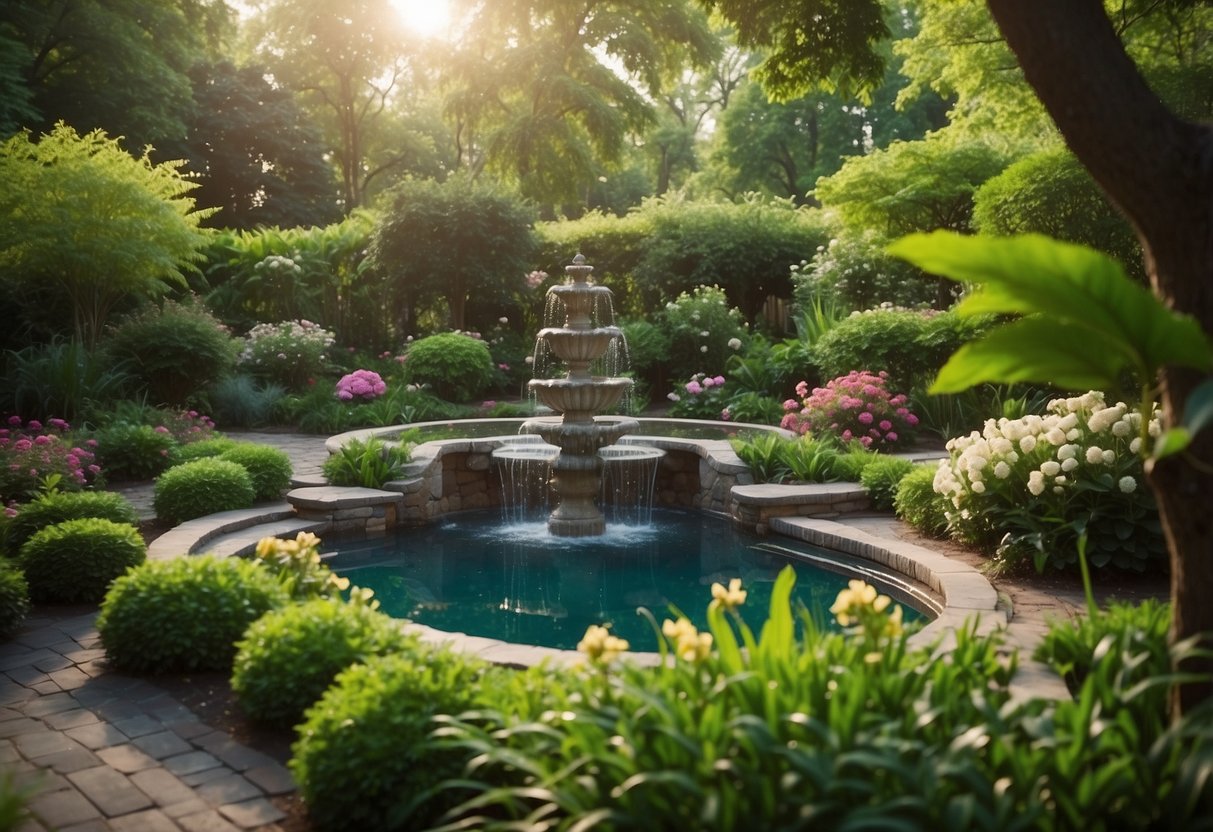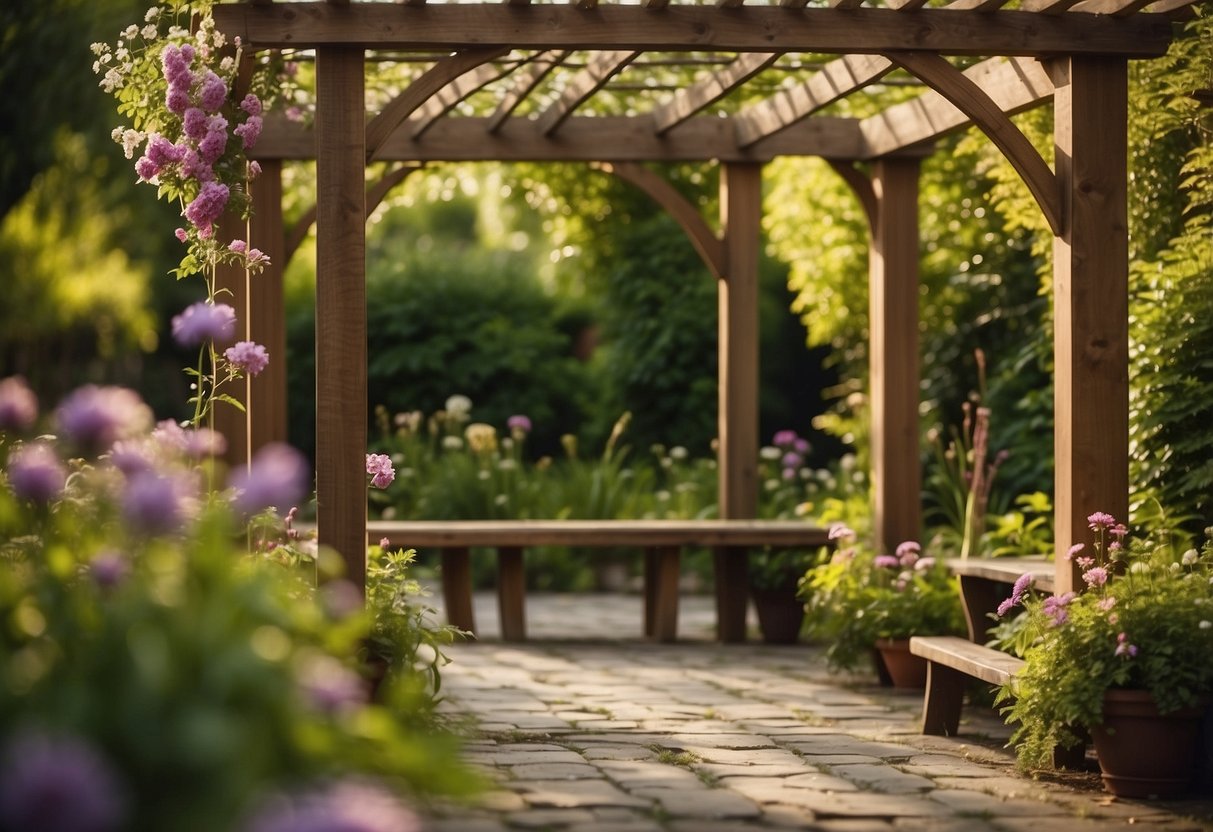Green Garden Ideas: Simple Tips for a Lush Backyard
Creating a green garden is a wonderful way to enhance your outdoor space while helping the environment. It’s all about making thoughtful choices that benefit not just your garden but also the planet. How can you start transforming your garden into a sustainable haven?

In this article, you’ll explore various green garden ideas that are both beautiful and eco-friendly. From choosing the right plants to incorporating sustainable practices, you’ll find plenty of inspiration to get started on your green garden journey.
1) Vertical Herb Garden

A vertical herb garden is great for small spaces. You can use pallets, old ladders, or even an Ikea bar cart turned into a mobile herb garden.
Try hanging shelves with terra-cotta pots for a neat look. Drill holes in pine boards to hold the pots and hang them with rope and zip ties. Check out these DIY vertical garden ideas for more inspiration.
A green herb teepee or vertical garden wall can also add charm to your patio. Vertical gardens are perfect for growing fresh herbs even in tight spaces like balconies or small yards.
2) Rainwater Harvesting System

Creating a rainwater harvesting system in your garden is a smart and eco-friendly choice. It helps you save water and reduce utility bills. Plus, it’s easy to set up.
Start with a basic rain barrel system next to your home. Use your roof as the catchment surface. Attach a downspout from your gutter to your barrel.
You can also use filters and screens to keep debris out of the collected water. This keeps your water clean and ready for use in your garden. For more DIY ideas, check out these rainwater harvesting systems.
3) DIY Garden Path

Creating a DIY garden path is a fun way to personalize your backyard. One option is using flagstone, which is easy to set in sand and looks stylish.
Wood chips are another low-cost option. They add a natural touch to your garden and are simple to lay down.
You could also try a grass pathway for a minimalist look. This requires no stones or gravel, just neatly lined plants to guide the way.
4) Butterfly-Friendly Plants

Adding butterfly-friendly plants to your garden can attract beautiful pollinators like butterflies.
Bee Balm offers vibrant, nectar-rich flowers that attract various butterflies, including checkered white and swallowtails. It’s easy to grow and thrives in most regions.
Blueberry Bushes are another great choice. The leaves provide food for caterpillars, and the flowers offer nectar for adult butterflies. Plus, you get delicious fruit.
Lavender with its calming scent and lovely flowers, is also butterfly-friendly. It grows well in full sun and can repel mosquitoes and ticks.
Including these plants will help create a lively, butterfly-friendly garden.
5) Composting Area

Creating a composting area in your garden is a great way to recycle kitchen scraps and yard waste. Composting turns waste into nutrient-rich soil for your plants.
Consider setting up a small bin or a larger compost pile, depending on your space. You can even start a worm bin if you have limited room.
Remember to layer your compost with “green” and “brown” materials. Keep it moist but not too wet. This simple effort helps reduce waste and boosts your garden’s health.
6) Raised Garden Beds

Raised garden beds are a fantastic way to grow your favorite plants. They offer better soil drainage and make it easier to control the soil quality.
These beds can be built from various materials, like wood, stone, or metal. You might enjoy planting vegetables like tomatoes and cucumbers or adding colorful flowers for a lively touch.
Consider setting up a tiered raised bed made of cedar fencing, which can even include a trellis for added support. This not only makes your garden look great but also provides a functional space for your plants to thrive.
Get inspired by more raised garden bed ideas to enhance your gardening space.
7) Wooden Pergola

A wooden pergola adds charm and shade to your garden. These structures are perfect for creating a cozy outdoor space. You can use a pergola to divide different areas, like separating your lawn from the patio.
Adding potted plants around the corners or climbing vines to your pergola can enhance its beauty. Consider using colorful flowers or fragrant vine plants for a delightful touch.
8) Greenhouse Kit

Building a greenhouse kit in your backyard is a fun project. You get to put all the pieces together yourself, which can save you money.
A DIY greenhouse kit usually comes with all the materials needed to assemble it. These kits are great for growing your own plants, no matter the weather.
You can personalize the greenhouse to fit your garden space and style. Happy building!
9) Solar Garden Lights

Solar garden lights are a great way to make your garden both beautiful and eco-friendly.
You can choose from solar garden flower lights, which add a magical touch to flower beds.
Hanging solar lanterns bring a warm, inviting glow.
For pathways, solar pathway lights can enhance safety and look great.
You can also light up your fences with solar fence lights, offering both security and style.
Enjoy the beauty and efficiency of solar lighting in your garden!
10) Recycled Garden Art

You can transform your garden by using recycled materials to create unique art pieces. For instance, turn an old tire into a colorful planter, giving both the tire and your garden a new life.
Repurpose glass to make stunning solar sculptures, combining eco-friendliness with beautiful garden decorations.
A worn-out colander can serve as a charming hanging planter, adding an unexpected touch to your outdoor space.
You could even use discarded drawer fronts to create interesting planters, making your garden both stylish and sustainable.
Get creative and try out these fun, eco-friendly ideas to brighten your garden.
Understanding Green Garden Design

Creating a green garden involves using methods that benefit the environment, like using sustainable materials and garden practices that conserve resources and promote biodiversity.
Principles of Eco-Friendly Gardening
Eco-friendly gardening means making choices that are good for the planet. One important principle is using native plants. These plants are adapted to your local climate and wildlife, so they need less water and care.
Another key principle is conserving water. You can do this by using drip irrigation systems and collecting rainwater in barrels. This helps reduce your garden’s need for extra water.
Composting is also essential. By turning kitchen scraps and yard waste into compost, you create rich soil that helps plants grow without synthetic fertilizers. This reduces landfill waste and provides nutrients to your garden naturally.
Choosing Sustainable Materials
When designing a green garden, the materials you choose matter. Permeable surfaces, like gravel or permeable pavers, help reduce rainwater runoff and are better for the environment than solid concrete.
For garden structures, use recycled or reclaimed wood. This not only reduces waste but also gives your garden a unique look. Avoid using pressure-treated wood because it can release harmful chemicals into the soil.
Mulch made from organic materials, such as wood chips or straw, helps retain moisture in the soil, reducing the need for frequent watering. It also breaks down over time, adding nutrients back into the soil.
By focusing on these principles and materials, you can create a beautiful, sustainable garden.
Plant Selection for a Green Garden

Selecting the right plants can make your garden both beautiful and sustainable. Focus on choosing native plants and drought-tolerant varieties to conserve water and support local wildlife.
Native Plants and Their Benefits
Native plants are those that naturally occur in your region. By choosing these plants, you support local ecosystems and provide food and shelter for native wildlife.
Native plants tend to be low-maintenance. They are adapted to your local climate and soil conditions, which means they require less water and fewer fertilizers and pesticides.
Some examples include coneflowers, goldenrods, and milkweeds in many North American gardens. These plants often attract pollinators like bees and butterflies, enhancing biodiversity in your garden. To explore more about plant selection, visit Garden Guides for Plant Selection.
Drought-Tolerant Plants for Water Conservation
Drought-tolerant plants are essential for saving water and ensuring your garden thrives even in dry conditions. These plants require minimal watering once established, making them perfect for areas prone to water shortages.
Agastache, a popular drought-tolerant plant, offers vibrant colors and aromatic foliage. Other examples include lavender, yarrow, and sedum. These plants can handle dry spells well and still produce beautiful blooms.
Planting drought-tolerant plants reduces water usage and helps maintain a lush garden with less effort. For more ideas, check out Best Perennial Flowers and Plants.
Maintaining Your Green Garden

Caring for a green garden involves adopting eco-friendly practices such as organic pest control methods and composting. These strategies will help you maintain a healthy and sustainable garden.
Organic Pest Control Methods
Managing pests organically ensures that your garden stays safe and eco-friendly. Introduce beneficial insects like ladybugs and lacewings to naturally control pests. These insects prey on harmful pests, reducing their numbers without chemicals.
Using physical barriers like row covers can protect your plants from insects and wildlife. This method acts as a shield, keeping pests away while allowing sunlight and rain to nourish your plants.
Planting aromatic herbs and flowers such as marigolds, chives, or basil can also deter pests. Their strong scents act as natural repellents, keeping insects at bay while adding beauty to your garden.
Composting for a Healthy Garden
Composting enriches your soil with nutrients, improving plant health and reducing waste. Start by collecting kitchen scraps like fruit peels, vegetable trimmings, and coffee grounds. Add yard waste such as grass clippings and leaves to your compost pile.
Maintain your compost by turning it regularly. This helps mix the materials and speeds up the decomposition process. Keep an eye on moisture levels; your compost should be as damp as a wrung-out sponge.
Use the finished compost as a natural fertilizer for your garden. Spread it around the base of your plants to enhance soil quality and support robust growth. By composting, you reduce waste and create a nutrient-rich environment for your garden.







